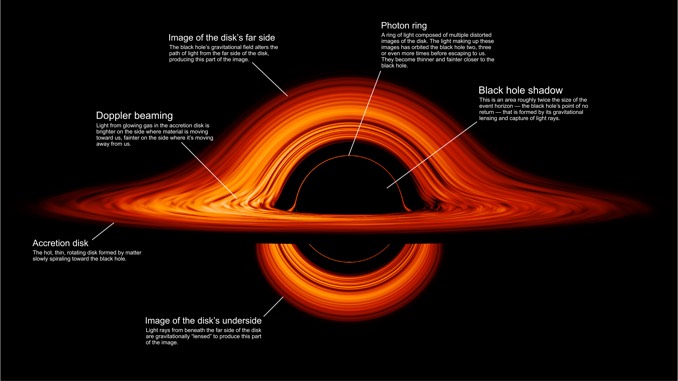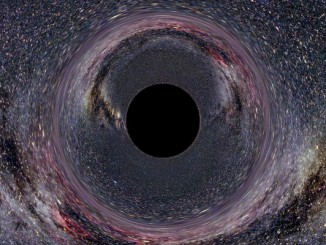Black holes are, by definition, invisible, the collapsed remnants of once massive stars with such enormous gravity that not even light can escape. But as gas and dust are sucked inward, spiralling into an accretion disk around the unseen hole, atoms and molecules are accelerated to enormous velocities, generating extreme temperatures and high-energy radiation that is, in fact, visible.
A new visualisation from NASA’s Goddard Space Flight Center illustrates how a black hole’s concentrated gravity warps the space surrounding it much like a carnival mirror distorts reflections.
Seen from an edge-on perspective, the accretion disc has a distinctly asymmetric appearance, with gas on the left side moving toward the viewer at such high speeds that radiation is given a relativistic boost in brightness. Gas on the right side that’s moving away from the viewer is slightly dimmer. The asymmetry vanishes when the disc is viewed face on because none of the material is moving along the viewer’s line of sight.
Light bending is most extreme close to the black hole where gas is orbiting at close to the speed of light. Bright knots form under the influence of magnetic fields that permeate the accretion disc and dissipate in the shears and stresses produced by differences in orbital velocity, producing light and dark lanes.

“Closest to the black hole, the gravitational light-bending becomes so excessive that we can see the underside of the disk as a bright ring of light seemingly outlining the black hole,” Goddard said in a description of the new animation. “This so-called ‘photon ring’ is composed of multiple rings, which grow progressively fainter and thinner, from light that has circled the black hole two, three, or even more times before escaping to reach our eyes.
“Because the black hole modelled in this visualisation is spherical, the photon ring looks nearly circular and identical from any viewing angle. Inside the photon ring is the black hole’s shadow, an area roughly twice the size of the event horizon — its point of no return.”
Jeremy Schnittman, a researcher at Goddard who generated the images using custom software, said the simulations “really help us visualise what Einstein meant when he said that gravity warps the fabric of space and time. Until very recently, these visualisations were limited to our imagination and computer programs. I never thought that it would be possible to see a real black hole.”
But last April, an image captured by the Event Horizon Telescope showed, for the first time, the shadow of a supermassive black hole at the heart of the galaxy M87.



